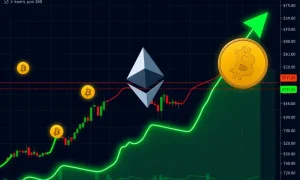The cryptocurrency market faces renewed pressure. Indeed, the recent US inflation report has triggered a significant Bitcoin sell-off, impacting not only digital assets but also traditional stocks. This market turbulence highlights the sensitive relationship between macroeconomic data and asset prices, particularly for those invested in the volatile crypto space.
Understanding the Drivers Behind the Bitcoin Sell-Off
Bitcoin (BTC) recently experienced a sharp pullback from its fresh all-time high of $123,400, dropping to $117,400 on Thursday. This correction occurred as hotter-than-expected US Producer Price Index (PPI) data surprised the market. The latest PPI print showed annual headline inflation at 3.3%, significantly above the 2.5% forecast and the previous month’s 2.3% reading. This marked the largest monthly rise in US PPI since June 2022.
Conversely, earlier Consumer Price Index (CPI) data on Tuesday presented a different picture. It outlined headline inflation holding at 2.7% year-over-year and core CPI at 3.1%. This initially reinforced a bullish case for risk assets, including Bitcoin. However, the stronger producer prices now signal persistent inflationary pressures. Consequently, the Federal Reserve might delay monetary easing, complicating the narrative for an immediate interest rate cut. For Bitcoin, this scenario could limit upside momentum in the short term, fueling the ongoing Bitcoin sell-off.
Federal Reserve’s Stance and the Bitcoin Sell-Off
Market expectations for a Federal Reserve interest rate cut have shifted dramatically. Data from CME FedWatch still points to a 90.5% probability of a 0.25% rate cut on September 17. However, this likelihood had spiked to 99.8% just a day prior, on Wednesday. This notable drop in probability reflects increased uncertainty following the PPI report. Investors closely watch the Fed’s decisions, as interest rate policies directly influence liquidity and risk appetite in financial markets. Therefore, any delay in rate cuts often translates into a more cautious approach from investors, exacerbating the Bitcoin sell-off.
🇺🇸 UPDATE: The probability of a U.S. Federal Reserve rate cut in September has risen to 99.8%. pic.twitter.com/vfHn97vxPY— StockPil (@StockPil) August 13, 2025
Technical Signals Driving the Bitcoin Sell-Off Further
While the hot US PPI print accelerated BTC corrections, bearish signals were observed even earlier. StockPil analysis noted a bearish divergence between price and the Relative Strength Index (RSI) after BTC tagged new highs above $123,000. This divergence often indicates weakening momentum despite rising prices, potentially leading to a liquidity grab from previous highs. Furthermore, the immediate price dip also formed a swing pattern failure, outlining possible choppy price action for the next few days. These technical indicators suggest that the current Bitcoin sell-off has underlying market structure reasons beyond just the inflation data.

Bitcoin four-hour chart. Source: StockPil/TradingView
Key Levels to Monitor During the Bitcoin Sell-Off
From a technical standpoint, Bitcoin’s recent leveraged unwind has absorbed key internal liquidity zones between $119,000 and $117,500. Currently, the most likely scenario could be a period of sideways consolidation following an 11% rise over the past 12 days. A bullish case would require a decisive close above $120,000 on the four-hour chart. However, the probability of a retest below $117,000 has increased due to a long-term market fractal pattern. On the three-day chart, BTC has formed a double top pattern, a structure previously observed during January.
This pattern led to a period of corrections during Q1 2025, during which BTC dropped as low as $75,000. If Bitcoin maintains support above $112,000, altcoins could thrive in a consolidation-driven setup. A drop below $112,000, however, would signal a shift in the lower time frame market structure. This could potentially trigger further corrections toward lower areas of interest between $105,000 and $110,000. Therefore, closely watching these levels is crucial for understanding the potential depth of the Bitcoin sell-off.

Bitcoin three-day chart. Source: StockPil/TradingView
Navigating the Current Market: Beyond the Bitcoin Sell-Off
The current market environment demands careful observation. The interplay between macroeconomic data, such as inflation reports, and Bitcoin’s price action remains a dominant theme. While the immediate outlook suggests caution, the cryptocurrency market’s resilience has been proven time and again. Investors should conduct thorough research and consider various market indicators before making any investment decisions. The ongoing Bitcoin sell-off serves as a reminder of the inherent volatility in digital assets and the importance of a well-informed strategy.
This article does not contain investment advice or recommendations. Every investment and trading move involves risk, and readers should conduct their own research when making a decision.
Frequently Asked Questions (FAQs)
Q1: What caused the recent Bitcoin sell-off?
The recent Bitcoin sell-off was primarily triggered by a hotter-than-expected US Producer Price Index (PPI) report. This report indicated persistent inflationary pressures, leading to concerns that the Federal Reserve might delay interest rate cuts, which typically dampens investor appetite for risk assets like Bitcoin.
Q2: How does US inflation affect Bitcoin’s price?
Higher US inflation often leads to expectations of tighter monetary policy from the Federal Reserve, such as higher interest rates. When interest rates rise, traditional investments like bonds become more attractive, and the cost of borrowing increases. This can reduce liquidity in the market and make riskier assets like Bitcoin less appealing, contributing to a Bitcoin sell-off.
Q3: What is a ‘double top pattern’ and why is it significant for Bitcoin?
A ‘double top pattern’ is a bearish technical analysis formation. It occurs when an asset’s price reaches a high, pulls back, then rises to a similar high again, and subsequently falls below a support level. For Bitcoin, this pattern suggests a potential reversal from an uptrend to a downtrend, signaling a deeper Bitcoin sell-off or correction, as seen in Q1 2025.
Q4: Will the Federal Reserve still cut interest rates in September?
The probability of a Federal Reserve rate cut in September has decreased following the recent PPI report. While CME FedWatch still shows a high probability (around 90.5%) of a 0.25% cut, this is down from nearly 100% just a day prior. The Fed’s decision will depend on ongoing economic data, particularly inflation trends.
Q5: How do altcoins react during a Bitcoin sell-off?
During a significant Bitcoin sell-off, altcoins often experience similar or even more pronounced price drops due to Bitcoin’s dominance and its role as a bellwether for the broader crypto market. However, if Bitcoin enters a period of sideways consolidation after a sell-off, some altcoins might find room to rally as investor focus shifts to smaller, potentially higher-growth assets.








